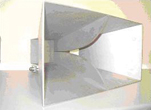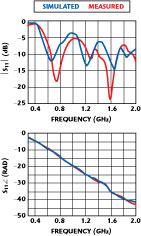Ultra-wide band (UWB) antennas are used in several applications, ranging from GPR prospecting, wireless communications, to detection for safety and non-destructive diagnostic sensing1-2. In particular, with regard to the specific issue of non-destructive microwave sensing, the availability of a larger band implies that it is possible to obtain images with a finer resolution3.
Furthermore, a reliable simulation of the behaviour of the antennas is relevant for antenna designers4, especially when complicated antennas (as UWB antennas usually are) must be dealt with. In this framework, because of the complexity of the geometrical parameters and the variety of the materials involved, as well as the constructive modalities of the feeding, the analysis of the final performances of the antenna is possible only with a full wave numerical code5.
In particular, in the case of GPR systems, the analysis of the antennas is made more difficult by the fact that they have to work close to or in contact with an air-soil interface or, in general, within an inhomogeneous medium. This affects both their impedance parameters and their radiation pattern, that can be quite different from the homologous quantities in free-space6.

Actually, in order to achieve an accurate characterization of the antennas in these situations, not only do all the details of the antennas have to be accounted for, but also some accurate information about the geometric and electromagnetic characteristics of the embedding environment is needed. Even though this knowledge is available, it is not precise enough for this purpose. However, in practical cases, even an approximate estimation of the characteristics of the inhomogeneous environment is sufficient to determine important antenna features.
In addition, when an inhomogeneous scenario is considered, while the measure of the scattering parameters of two antennas is easily carried out, any direct measurement of the radiation pattern is much more difficult7. This increases the relevance of achieving reliable simulations of the antennas. In particular, in the field of GPR prospecting, one may test the accuracy of the simulation by comparing the numerically computed scattering parameters with the experimentally measured ones and, if a good agreement is achieved, one can retrieve reasonably valuable information about the antenna pattern numerically. In particular, one can approximately guess the width of the main lobe, or can check the undesired occurrence of a multi-lobe pattern.
In this article, the modeling and characterization of two ridged-horn antennas, designed for GPR prospecting or in general for non-destructive testing, is dealt with. The antennas are simulated in free space and in contact with a tuff masonry, by means of an FEM8- based commercial code HFSS/Ansoft9. Such a code allows getting a full wave three-dimensional model of the feeding and the radiating parts of the antennas. This article follows a previous one devoted to the characterization of two bow-tie antennas10. Compared to the bowtie antennas, the ridged horn antennas are less complicated with regard to the materials. However, they are quite larger and many of their geometrical details were not reported in their data sheet, so that they had to be measured accurately in order to perform the numerical simulations. The simulated scattering parameters are compared with the measurements collected in the laboratory of electromagnetic diagnostics of the Dipartimento di Ingegneria dell’Informazione at the Second University of Naples (Italy).

The Antennas and Their Modeling
The ridged-horn antennas under test have been designed by RST Raumfahrt Systemtechnik GmbH, Salem, Germany. In particular, each of the two antennas consists of a pyramidal horn radiation cavity and two metallic ridges with exponential taper as shown in Figure 1. The dimensions of the main and smaller face of the pyramidal horn are 43 x 23 cm and 20.5 x 10.8 cm, respectively. The length is 32 cm. The pyramidal horn is connected to the outer conductor of the coaxial feed and serves as a ground plane, providing a current return path. The combined use of the inner and outer conductors of the feed creates a balun transformer for the ridges. The ground plane also helps to confine the main beam of the radiation pattern at the aperture of the horn, so as to ensure a compact radiation pattern.
The numerical analysis of the antenna has been performed for the full three-dimensional model by HFSS. The geometric model is divided into a large number of tetrahedra, where each single tetrahedron is a four-sided pyramid. This collection of tetrahedra is referred to as the finite element mesh. The curved metal surfaces of the antenna are modeled through a triangular mesh, constituted by the tetrahedra faces. The code uses an iterative process, called adaptive analysis, where the mesh is automatically refined in critical regions. First, a solution based on a coarse initial mesh is generated, then the mesh is refined in areas of high error density and a new solution is generated. When some selected parameters converge to some limit value, the code breaks out of the loop, when a Cauchy criterion11 is exploited. As for most commercial codes, this involves the problem of simulating the infinity of the external medium, both in the case that this is made up of free space and when it is an inhomogeneous medium. The problem is faced by making use of the boundary conditions provided by the code itself and, in particular, the standard radiation conditions have been used.

Numerical and Experimental Results
In this section, the results of the FEM based analysis are compared with experimental data. A reflection configuration is considered, where the two antennas (transmitting and receiving) are close to each other and are placed on the same side of the object under test. This reflection configuration is the one customarily exploited in GPR prospecting. An example of the geometry is shown in Figure 2, where the horns’ apertures lay in the x, y plane and are aligned along the y-axis. The UWB performances of the antennas are evaluated in terms of the scattering matrix between the input port of the transmitting antenna and the output port of the receiving antenna. The reference ports are located at the connectors on the back of the two antennas. The chosen convergence criterion for the FEM code is based on the change of the four elements Sij (i,j=1,2) of the scattering matrix between two consecutive iterations at finer meshes. In particular, when at the N-th iteration,


where i and j cover all matrix entries.
When ΔS ≤ 0.01, the iterations analysis stop; otherwise, they continue with a finer mesh, up to a pre-fixed maximum number of iterations. In the case at hand, the scattering parameters have been calculated assuming a 50 Ω characteristic impedance of the feed-line. The results of the numerical analysis have been compared with measurements collected at the electromagnetic diagnostics laboratory of Second University of Naples. The antennas are fed by an ANRITSU 37225B network analyser (VNA), covering a band of 40 MHz to 13.5 GHz, connected to the antennas by means of two coaxial cables. The network analyser port impedance and the intrinsic impedance of the coaxial cables are equal to 50 Ω, and are consistent with the choice of the characteristic impedance of the feed lines used in the simulations. The near field scattering parameters have been measured in free space, using an automatic 2D positioning system, located in an anechoic chamber (see Figure 3). However, the measurements for the antennas in contact with the tuff masonry have been collected by a different system in a semi-anechoic environment.
As an index of the agreement between simulated and measured scattering parameters, the following correlation coefficient was adopted:


where SM(f) and ST(f) denote the measured and the numerically calculated scattering matrix element, respectively, and * stands for the complex conjugate. The integrals in Equation 2 are calculated within the working frequency band of the antennas, which is 0.5 to 3 GHz.
The Free-space Case

The first analysis is performed for a single antenna in free space and, in this case, the only scattering parameter to be considered is S11. The analysis dealt with here is useful, since the accurate numerical determination of this scattering parameter, when compared to the measured one, leads one to consider the simulation of the constructive features of the antenna to be reliable.
Figure 4 shows the agreement between the numerically evaluated and the measured scattering parameter S11 in the time-domain. The time domain quantities are obtained by a Fourier transform of the scattering parameters in the frequency domain. The good agreement between measurements and computation is also confirmed by the correlation factor r=0.94, evaluated for the scattering parameter S11in the frequency domain.

To increase the confidence in the accuracy of the antenna simulation, a numerically evaluated significant component of the aperture field (more precisely the y-component) in modulus and phase is shown in Figures 5, 6 and 7 for three different frequencies within the operating band. In particular, the frequencies 0.5, 1.6 and 2.5 GHz have been considered. It can be seen that as the frequency increases the field is more and more confined between the two ridges of the antennas: it is known that this is the usual behavior for this kind of antenna12.
For the analysis of the single antenna, the discretization of the box (whose dimension is λ max x λ max x λ max) involves about 150,000 tetrahedra and the computation time for the entire frequency band is approximately four hours using the dual processor AMD Opteron 64 bit, 6 GB DDR SDRAM. After the case of the single antenna, the case of two antennas in free space was considered. The two aperture antennas are aligned along the y-axis and quasi in contact at the aperture edges (see Figure 8).

First, the scattering parameter S11 is considered, which accounts for the influence of the receiving antenna on the mismatching of the transmitting one. The measured data and computation are consistent and the correlation coefficient is r=0.9. The parameters of the impedance matrix are linked in a well-known way to the parameters of the scattering matrix13.
Figure 9 shows the comparison between the measured (red line) and the computed (blue line) real and imaginary parts of the self-impedance parameter Z11. The same analysis has also provided the impedance parameter Z21, which accounts for the mutual coupling between the transmitting and receiving antenna. Figure 10 shows the good agreement between the real and imaginary parts of the measured and computed values. The consistency between the measurements and the computation results are confirmed also by the correlation coefficient, which for the scattering parameter S21, is equal to r=0.87.
The Case of Antennas on Tuff Masonry

Consider the case of the two antennas placed in front of a tuff masonry. Tuff is a porous material largely present in South Italy and used in the construction of historical buildings. The configuration is the same as the free space case and the antennas are directly in contact with the masonry. The thickness of the masonry is 11 cm. The electromagnetic behaviour of tuff has been characterized independently, and the analysis assumes a relative dielectric permittivity equal to 5 and a conductivity equal to 0.01 S/m. Figure 11 shows the comparison between the numerically evaluated and the measured magnitude and phase of the scattering parameter S11. The correlation index is r= 0.81. Again, the scattering parameter S21 is considered. In this case also, a good agreement is observed between the numerically evaluated and the measured scattering parameters (see Figure 12). The correlation index is r= 0.67. As a comment, for the case of tuff masonry, the agreement between the measured and computed quantities is less consistent; this is due to the fact that the frequency behaviour of the permittivity and conductivity of the tuff is not accounted for.
For the analysis of the two antennas, the discretization of the box (whose dimension is λ max x λ max x λ max) involves about 200,000 tetrahedra and the computation time for the entire frequency band is approximately six hours on an AMD Opteron 64 bit, 6 GB DDR SDRAM dual processor.

Conclusion
In this article, the reliability and accuracy of a FEM-based numerical analysis, accounting for the full complexity of ridged horn antennas in free space and close to a tuff masonry has been shown. In particular, the results of the numerical analysis are consistent with the experimental measurements both in the free-space and in the more challenging case of a non-homogeneous scenario. This activity is of interest in GPR prospecting, where the choice of the antennas to be used depends also on the electromagnetic features of the investigated structure.
References
1. D. J. Daniels, Ground Penetrating Radar, 2nd Edition, The Institution of Electrical Engineers, Stevenage, UK, 2004.
2. T.P. Montoya and G. S. Smith, “Land Mine Detection Using a Ground-Penetrating Radar Based on Resistively Loaded Vee Dipoles”, IEEE Transactions on Antennas and Propagation, Vol. 47, No. 12, 1999, pp.1795-1806.
3. D. A. Noon, Stepped-Frequency Radar Design and Signal Processing Enhances Ground Penetrating Radar Performance, Ph.D. Thesis, Department of Electrical & Computer Engineering, University of Queensland, Australia, 1996.
4. F. Soldovieri, R. Persico and G. Leone, “Effect of Source and Receiver Radiation Characteristics in Subsurface Prospecting Within the DBA”, Radio Science, Vol. 40, RS3006, May 2005.

5. H. Nakano, Y. Okabe, H. Mimaki, and J. Yamauchi, “A Monofilar Spiral Antenna Excited Through a Helical Wire”, IEEE Transactions on Antennas and Propagation, Vol. 51, No. 3, 2003, pp. 661-664.
6. G. Prisco and R. Persico, “Antenna Characterization in Near Field and in Inhomogeneous Media: Their Use in Microwave Imaging,” Proceedings of the Leading Inside Workshop, Rome, 15 November 2006.
7. P. Meincke and T. B. Hansen, “Plane-Wave Characterization of Antennas Close to a Planar Interface,” IEEE Transactions on Geoscience and Remote Sensing, Vol. 42, No. 6, 2004, pp. 1222-1232.
8. J. L. Volakis, L. C. Kempel and A. Chatterjee, Finite Element Method for Electromagnetics, IEEE Press, Piscataway, NJ, 1998.
9. http://www.ansoft.com/products/hf/hfss/
10. F. Soldovieri, G. Prisco, A. Brancaccio and G. Leone, “Characterization of Ultra-wideband Bow-tie Antennas for Ground Penetrating Radar Systems”, Microwave Journal, Vol. 49, No. 8, August 2006, pp. 186-194.
11. R. Beals, Analysis: An Introduction, Cambridge University Press, Cambridge, UK, 2004.
12. www.ifh.ee.ethz.ch/~fvtd/fvtd_horn.html
13. R. Collin, Foundation for Microwave Engineering, 2nd Edition, Institute of Electrical and Electronics Engineers, Piscataway, NJ, 2001.
 Francesco Soldovieri received the Laurea degree in electronic engineering from the University of Salerno in 1992, and the PhD degree in electronic engineering from the University of Naples “Federico II” in 1996. In 1993, he joined the electromagnetic research group of the University of Naples and in 1998/1999, he held a postdoctoral fellowship at the same university. In 1999-2000, he collaborated with the research group on applied electromagnetism at the Second University of Naples. Since 2001, he has been a researcher at the Institute for Electromagnetic Sensing of the Environment of the Italian National Research Council (IREA-CNR). His main scientific interests include electromagnetic diagnosis, inverse scattering and GPR applications.
Francesco Soldovieri received the Laurea degree in electronic engineering from the University of Salerno in 1992, and the PhD degree in electronic engineering from the University of Naples “Federico II” in 1996. In 1993, he joined the electromagnetic research group of the University of Naples and in 1998/1999, he held a postdoctoral fellowship at the same university. In 1999-2000, he collaborated with the research group on applied electromagnetism at the Second University of Naples. Since 2001, he has been a researcher at the Institute for Electromagnetic Sensing of the Environment of the Italian National Research Council (IREA-CNR). His main scientific interests include electromagnetic diagnosis, inverse scattering and GPR applications.
 Giancarlo Prisco received the Laurea and PhD degrees in electronic engineering from the Second University of Naples, Aversa, Italy, in 2002 and 2005, respectively. Since 2003, he has collaborated with the research group on applied electromagnetism at the Second University of Naples. His scientific interests include UWB antennas, inverse scattering and GPR applications.
Giancarlo Prisco received the Laurea and PhD degrees in electronic engineering from the Second University of Naples, Aversa, Italy, in 2002 and 2005, respectively. Since 2003, he has collaborated with the research group on applied electromagnetism at the Second University of Naples. His scientific interests include UWB antennas, inverse scattering and GPR applications.

 Raffaele Persico received his electronic engineering degree from the University of Naples Federico II in 1996 and the PhD degree from the second University of Naples in 1999. He has been a research scientist in the Consortium for Advanced Research in Remote Sensing Systems (CO.RI.S.T.A.) and in the Institute for the Electromagnetic Sensing of the Environment (I.R.E.A.). Since January 2007, he has been a research scientist in the Institute for Archaeological and Cultural Heritage (I.B.A.M., Lecce, Italy). His main research interests include linear and nonlinear inverse scattering problems and related topics, especially in relationship with GPR data processing.
Raffaele Persico received his electronic engineering degree from the University of Naples Federico II in 1996 and the PhD degree from the second University of Naples in 1999. He has been a research scientist in the Consortium for Advanced Research in Remote Sensing Systems (CO.RI.S.T.A.) and in the Institute for the Electromagnetic Sensing of the Environment (I.R.E.A.). Since January 2007, he has been a research scientist in the Institute for Archaeological and Cultural Heritage (I.B.A.M., Lecce, Italy). His main research interests include linear and nonlinear inverse scattering problems and related topics, especially in relationship with GPR data processing.
 Harald Lentz received his degree in electrical engineering from the Technical University, Berlin, Germany. Since 1996, he is with Raumfahrt Systemtechnik GmbH, Germany, where he is the head of the hardware development department. His work is focused on radar systems for spaceborne, airborne as well as ground penetrating applications.
Harald Lentz received his degree in electrical engineering from the Technical University, Berlin, Germany. Since 1996, he is with Raumfahrt Systemtechnik GmbH, Germany, where he is the head of the hardware development department. His work is focused on radar systems for spaceborne, airborne as well as ground penetrating applications.
